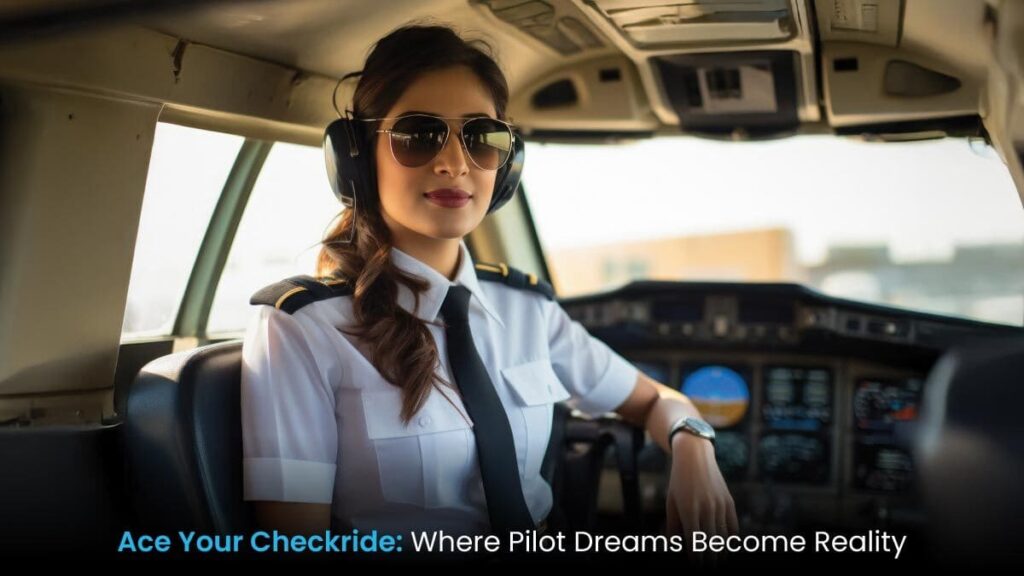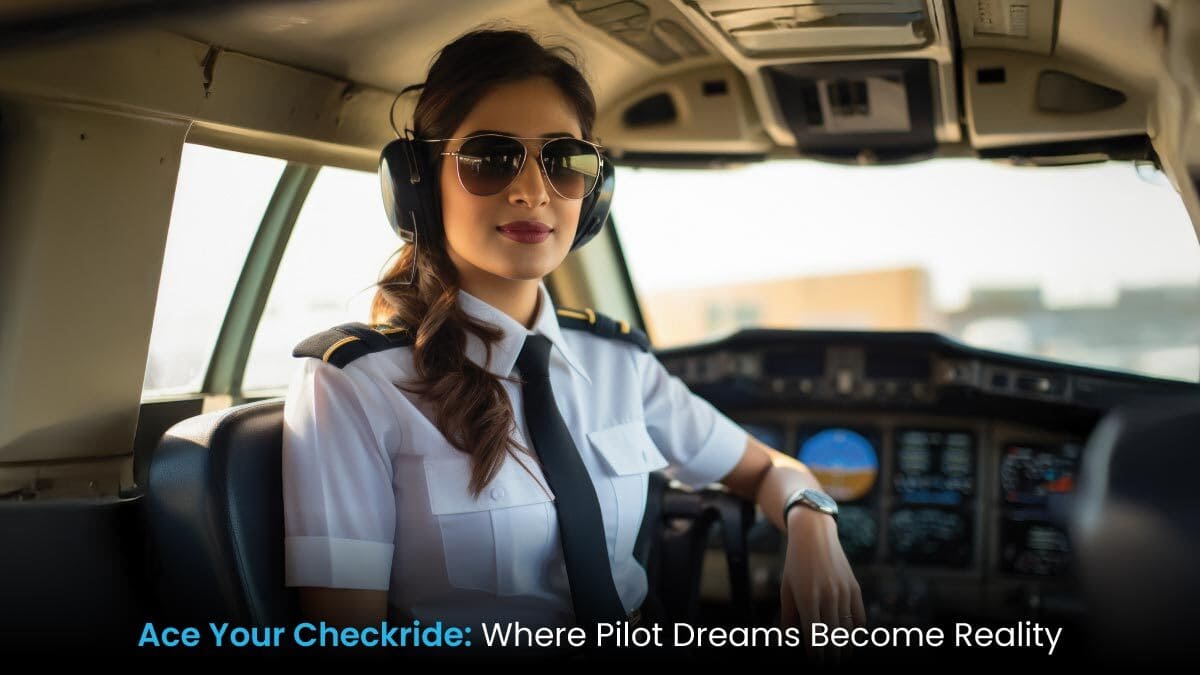
You’ve done the hard work. You’ve flown many hours and studied a lot. Now, you’re about to take the big test: your checkride. Feeling nervous? That’s totally normal. Whether it’s your private pilot checkride or your CPL test, everyone feels the pressure. But don’t worry—you’re more ready than you think.
At Insight Aviation, we help students get through this final step with confidence. Here’s what a check-ride is, how to get ready, and why it’s more than just a test—it’s your ticket to becoming a real pilot.
What Is a Checkride?
A checkride is the last big step in getting your pilot license in India. It has two parts:
- Oral Exam: An examiner asks you questions. They might ask about weather, rules, maps, and how your airplane works (these are called aircraft systems). They don’t want you to just repeat things—they want to see if you really understand how to fly safely.
- Flight Test: You’ll go flying with the examiner. They’ll ask you to show maneuvers and handle situations like emergencies. They watch how you prepare, how you think ahead, and how safely you fly.
Whether you’re doing your PPL or CPL, the steps are mostly the same. This test checks if you’re really ready to be a safe and smart pilot.
Feeling Nervous? That’s Okay
Let’s be honest—most people feel scared before their checkride. Even experienced pilots remember being nervous. But here’s a secret: you don’t have to be perfect.
Examiners want to see pilots who:
- Know their airplane
- Put safety first
- Talk clearly to others
- Stay calm when things don’t go perfectly
Think of the checkride like a solo flight. You’ve practiced this. Now it’s time to show it. Instead of thinking, “What if I mess up?”, try thinking, “How can I show what I know?” That small change in thinking can help you stay calm.
Take deep breaths. You’ve trained for this. You can do it.
What Examiners Look For
Don’t listen to scary stories. Examiners aren’t there to trick you. They want to see if you:
- Are you aware of what’s happening in the flight
- Know how your aircraft systems work
- Use checklists the right way
- Talk clearly to Air Traffic Control and your crew
If you make a small mistake and fix it, that’s okay! It shows you know how to handle real flying. Being honest and calm matters more than trying to act perfect.
How to Prepare for Your Checkride
Think of getting ready in three parts: what you know, what you practice, and how you think.
1. Oral Exam Topics to Study
Make sure you know:
- Indian air laws and DGCA rules
- Weather (especially during monsoons)
- Maps and navigation
- Flight planning
- How your airplane performs
- What to do in emergencies
- Your aircraft systems (engine, fuel, electrical parts, etc.)
Tip: Say your answers out loud when you practice. It helps you stay sharp during the real thing. Try using flashcards or asking a friend to quiz you.
2. Simulator Practice
Use your sim time to:
- Practice emergencies (like engine failure or losing instruments)
- Improve your flying and scanning skills
- Practice your radio calls
- Use checklists just like in a real flight
- Repeat important steps like landing or taking off after an engine failure
At Insight Aviation, our simulators are just like the planes you’ll fly. This makes you feel more ready on the big day.
3. Pack the Right Stuff
Before the checkride, make sure your bag has:
- Your ID and medical papers
- Your logbook with all flight hours signed
- License form with your photo
- Your flight plan and nav log
- Airplane documents (manual, weight & balance, maintenance papers)
- Pens, calculator, extra batteries—and confidence!
Being neat and ready shows you’re serious about being a pilot.
Know Your Aircraft Systems
This is a big one. Lots of students get stuck here. Don’t just memorize—understand how things work.
Be ready to explain:
- How your ignition system works
- What happens if the alternator fails
- How fuel moves from the tank to the engine
- What the pitot-static system does
- The difference between types of propellers
- How your brakes work
Tip from our instructor: “Picture the aircraft in your head and imagine each system. It helps a lot!”
Also, read your aircraft’s Pilot Handbook carefully. Mark the important parts and know your limits.
Myths to Forget
Myth 1: One mistake means you fail.
Truth: Fixing mistakes shows you’re a smart pilot.
Myth 2: The examiner wants to fail you.
Truth: They want to see if you’re safe. That’s all.
Myth 3: You need to know everything.
Truth: You need to know your stuff—but it’s okay to admit if you don’t know something. Just explain how you’d find the answer.
Myth 4: It’s just a regular flight.
Truth: It’s more serious, but you’ve practiced everything before.
Insight Aviation: We’ve Got Your Back
At Insight Aviation, we help you train like a real pilot. Our instructors care about your success. We offer:
- One-on-one sessions before and after flights
- Classes to go over important systems
- Practice flights with real-life situations
- Support from other students who’ve been there
We don’t just teach you to fly—we teach you to think and act like a real-world pilot.
You’re Ready. Let’s Fly.
Your checkride isn’t the end—it’s the beginning. It’s the last step before you become a licensed pilot. You’ve worked hard, and now it’s time to prove it.
So, take a deep breath. Trust your training. Walk into that cockpit knowing you belong there.
This is the moment where your student life ends and your flying career begins.
Welcome to the skies. You’ve earned it.
FAQ’s
Q: What is a checkride?
A: A checkride is the final flying test (Skill Test) taken with a DGCA examiner to get your pilot license. It includes a ground oral exam and a flight test.
Q: How long does a checkride usually take?
A: It usually takes 4 to 6 hours, including both the oral and flight test.
Q: What should I bring to my checkride?
A: Carry your logbook, ID proof, medical certificate, DGCA exam results, license (if any), and aircraft documents.
Q: Can I fail my checkride for small mistakes?
A: No, small mistakes won’t lead to failure if you stay safe and correct them. Big errors or unsafe flying can lead to a failure.
Q: How can I prepare effectively for my checkride?
A: Practice with your instructor, revise all DGCA subjects, know your aircraft well, and stay calm and confident.
Q: What happens if I don’t pass the checkride?
A: You can retake the test after some extra training. Many pilots don’t pass on the first try—it’s okay.
Q: What type of aircraft should I use for my checkride?
A: Use a DGCA-approved aircraft that is well-maintained, airworthy, and suits the license you’re testing for (like CPL or PPL).

